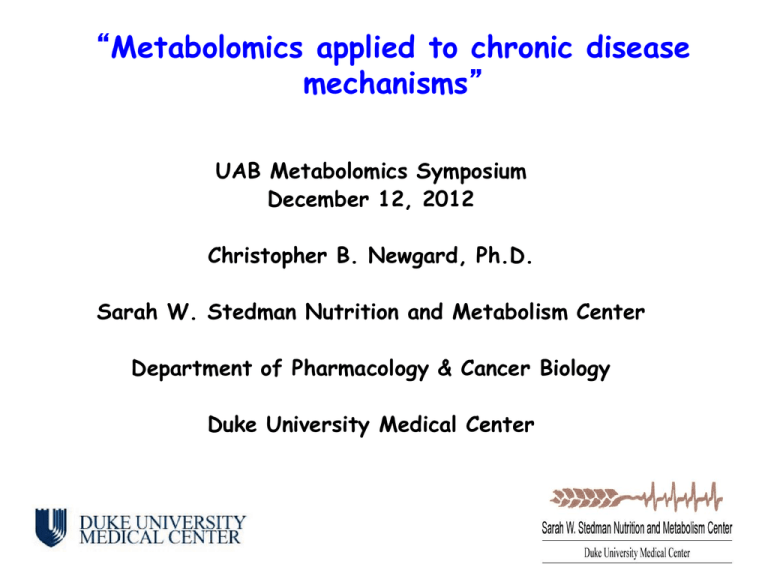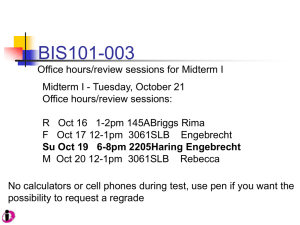Takeda/Duke/RTI meeting
advertisement

“Metabolomics applied to chronic disease mechanisms” UAB Metabolomics Symposium December 12, 2012 Christopher B. Newgard, Ph.D. Sarah W. Stedman Nutrition and Metabolism Center Department of Pharmacology & Cancer Biology Duke University Medical Center Evolving Metabolic Profiling Platform Stedman Nutrition and Metabolism Center, Duke Definition: Development of Comprehensive Tools for Metabolic Analysis of Cultured Cells, Animal Models, and Clinical Samples,via… “Targeted” MS Methods • GC/MS and MS/MS for “targeted” analysis. Current capability, 250 metabolites in 9 classes (free fatty acids, total fatty acids, LC acyl CoAs, SC acyl CoAs, acyl carnitines, organic acids, amino acids, purine precursors/nucleotides, ceramides/sphingolipids) • Modules for sterols, phospholipids, and eicosanoids in development “Non-Targeted” MS Methods • ~1000 compound spectral library developed (with Agilent, Oliver Fiehn, UC Davis) for non-targeted GC/MS • LC-MS/MS for non-targeted analysis of thousands of metabolites/sample Uses of comprehensive metabolic profiling tools (metabolomics) Metabolic signatures of human disease states, including obesity, type 2 diabetes, CVD Hypothesis generation engine for mechanistic studies in cells and animal models Integration of metabolomics with other “omics” sciences (genomics, transcriptomics) for identification of novel regulatory pathways Use of non-targeted metabolomics for discovery applications Obese vs. lean study: clinical characteristics Measure Obese (n=74) Lean (n=67) p-value Age 52.4 ± 10.9 50.2 ± 12.5 NS Height 66.4 ± 4.0 67.9 ± 3.9 NS Weight 235 ± 46 149 ± 20 < 0.0001 BMI 37.4 ± 5.3 22.8 ± 1.6 < 0.0001 Association of a BCAA-Related PCA Factor with Insulin Resistance in Humans 30 HOMA 25 20 R = 0.604 Lean Subjects 15 Obese Subjects 10 5 0 -2 0 2 4 6 PCA Factor 1* *PCA factor 1 comprised of Val, Leu/Ile, Glx, C3AC, C5AC, Phe, Tyr Newgard, et al. Cell Metabolism 9: 311, 2009 Important Questions Are BCAA predictive of disease or intervention outcomes? Are BCAA responsive to our best current diabetes/obesity interventions? Do increased BCAA and metabolites contribute to development of insulin resistance? What are the mechanisms for increased circulating BCAA? Poor association of weight loss and ∆HOMA in WLM subjects _______________________________ ________________ 6 HOMA increased from entry to baseline. 4 ∆HOMA 2 0 -2 -4 HOMA decreased from entry to baseline. -6 -8 -10 4.0 9.0 14.0 19.0 24.0 Change in Weight (Baseline – 6 months) 29.0 Factor Univariates for HOMA-Change Model Entry Variable F1 F2 F3 F4 F5 Factor name F val P-val Effect Size (95% CI) Medium Chain Acylcarnitines Medium Chain Dicarboxyl-acylcarnitines Branched-Chain Amino Acids (BCAA) C2, C4-OH, C16:1, Total Ketones, 3-OH Butyrate, Nonesterified Fatty Acid C18:1-OH/C16:1-DC, C18-OH/C16-DC, C20, C20:1-OH/C18:1-DC, C20-OH/C18-DC 0.08 0.78 -0.02 (-0.17, 0.13) 1.96 0.16 -0.11 (-0.26, 0.04) 47.82 <.0001 -0.51 (-0.66, -0.37) 1.19 0.28 0.08(-0.07, 0.24) 0.32 0.57 -0.04 (-0.20, 0.11) Shah, et al. Diabetologia 55: 321, 2012 Science Translational Medicine 3: 80re2, 2011 Larger decrease in BCAA (molar sum) in GBP compared to dietary intervention matched for weight loss * * Laferrere, et al., Science Transl. Med. 3: 80re, 2011 Columbia cohort Duke cohort C3 + C5 Acylcarnitines decreased in GBP versus dietary intervention C3 + C5 Acylcarnitines Total Acylcarnitines 1.0 Total C3 and C5 umol/L 0.9 0.8 0.7 * 0.6 0.5 0.4 0.3 0.2 0.1 0.0 GBP Laferrere, et al., Science Transl. Med. 3: 80re, 2011 Diet Rats fed HF/BCAA are insulin resistant despite normal body weight Newgard CB, et al. Cell Metabolism, 2009 HF + BCAA feeding induces acylcarnitine accumulation despite lower rate of food intake Does this mean that BCAA restriction might improve insulin sensitivity? Feed Zucker-obese or Zucker-lean rats on standard chow, or standard chow with 45% depletion of BCAA in diet (not growth limiting) Assess insulin sensitivity and metabolic profiles after 10 weeks of feeding Phillip White, Amanda Lapworth, Jie An, ChinMeng Khoo, Erin Glynn BCAA Restriction enhances insulin sensitivity: Isoglycemic Hyperinsulinemic Clamp 18 18 16 GIR (mg.kg.min-1) 14 12 10 OB CTL (n-5) 8 OB 45% DEF (n-5) 6 4 Mean GIR (mg.kg.min-1) 16 * 14 12 10 8 6 4 2 2 0 0 0 10 20 30 40 OB CTL (n-5) 50 Time (minutes) OB 45% DEF (n-5) 20 20 18 18 16 16 14 12 10 OB CTL (n-5) 8 OB 45% DEF (n-5) 6 4 Mean Glycemia (mM) Glycemia (mM) *p = 0.03 14 12 10 8 6 4 2 2 0 0 10 20 30 Time (minutes) 40 50 0 OB CTL (n-5) OB 45% DEF (n-5) What causes BCAA to rise in human metabolic diseases? Essential amino acids Gut microbiome Genetics oxidation Branched Chain Amino Acids Aromatic Amino Acids Shah, Svetkey & Newgard Cell Metabolism 13: 491, 2011 protein Diagnostic Read-Out Newgard, CB. Cell Metabolism 15:606, 2012 Why are Aromatic Amino Acids Always Part of the BCAA-related Metabolite Signature? Hypothesis: The BCAA/aromatic amino acid metabolic signature provides a clue to the mechanism underlying the association of obesity with behavioral disorders (anxiety, depression) TRANSPORT OF LNAA THROUGH THE BLOOD BRAIN BARRIER Dopamine Serotonin Leu Iso Val Leu Leu Val Iso Leu Norepinephrine Trp Leu Val Tyr Val Leu Iso Leu Trp Iso Leu Phe Iso Leu Tyr Val Val Leu BCAA supplementation of energy-dense diets reduces Trp and Tyr Levels in frontal cortex ANOVA, BCAA, p < 0.002 Coppola, et al. Am. J. Physiol. in press, 2012 BCAA supplementation of energy-dense diets causes anxious behavior (elevated maze test) ANOVA, BCAA, p < 0.002 Anna Coppola Fluoxetine (Prozac) Does Not Reverse BCAAinduced Anxious Behavior…… Anna Coppola ……but Tryptophan Does Anna Coppola Anna Coppola Trp supplementation normalizes kynurenic acid levels in frontal cortex Anna Coppola Metabolomic Profiling in CATHGEN – Study 1 • Subjects with coronary artery disease (CAD) compared to raceand sex-matched controls, index and validation cohorts. – Study 2 • CAD cases who experienced CV events (MI, CV-related death within 2 yr. of follow up) and controls with no events; index and validation cohorts. – Study 3 • Nested prospective study of 2023 consecutive subjects undergoing diagnostic cardiac catheterization, with CV events as outcome. – Study 4 • Adverse outcomes in 478 subjects that underwent coronary artery bypass surgery (CABG). Shah et al, Circulation Cardiovasc. Genetics 3: 207, 2010 Shah et al, Am. Heart Journal 163: 844, 2012 Shah, et al. J. Thoracic Cardiovasc. Surgery 143: 873, 2012 Shah, Kraus, Newgard, Circulation 126: 1110, 2012 Metabolites in DC-AC principal component clusters that predict CVD events 1. Case/control CATHGEN study: C5-DC, C6:1DC/C8:1-OH, C8:1-DC, C6-DC, citrulline 2. Nested prospective CATHGEN study: C6:1DC/C8:1-OH, C8:1-DC, C6-DC, C5-DC, Ci4DC/C4DC, C5-OH/C3-DC, C10-OH/C8-DC, C10:3 3. CABP study: Ci-DC/C4-DC, C5-DC, C6-DC, C6:1DC/C8:1-OH, C8:1, C8:1-DC, C10:1, C10:2, C10:3, C10-OH/C8-DC, C12-OH, C10-DC, citrulline Common to all 3 sets Common to 2 sets Dicarboxylated acylcarnitines Predict Incident CVD Events 1 2 3 Median follow-up 3.1 yrs, 232 Deaths Shah, Newgard, Hauser, Kraus, Newby et al., American Heart Journal 2012. st Tertile nd rd Tertile Tertile Ongoing Studies Study Population: N=3500 from CATHGEN biorepository, 70% with CAD, 29% with T2D • All 3500 have targeted, quantitative metabolomic profling • • All have GWAS (Illumina Omni chip) genotyping completed • • All have peripheral blood gene expression profiling (Illumina microarray) Allows analysis of genetic architecture underlying metabolic variability in this population Acknowledgments Our laboratory Jie An Erin Glynn Phillip White Amanda Lapworth Dorothee Newbern Chinmeng Khoo Helena Winfield Danhong Lu Sam Stephens Jeff Tessem Lisa Poppe Anna Coppola Mette Valentin Jensen Taylor Rosa Michelle Arlotto Paul Anderson Tom Becker (Faculty) Heather Hayes Hans Hohmeier (Faculty) Jonathan Haldeman Larry Moss (Faculty) Jennifer Moss (Faculty) Collaborators James Bain (Faculty), Robert Stevens (Faculty), Brett Wenner, Olga Ilkayeva, Mike Muehlbauer, Stedman Center Core Laboratory; David Millington Debbie Muoio, Tim Koves, Duke Stedman Center Alan Attie, Mark Keller, University of Wisconsin Bill Kraus, Svati Shah, E-Shyong Tai, Aslan Turer, Beth Hauser, Mihai Podgoreanu, Laura Svetkey, Lillian Lien, Andrea Haqq, Blandine LaFererre, Alfonso Torquati—Clinical Collaborators









